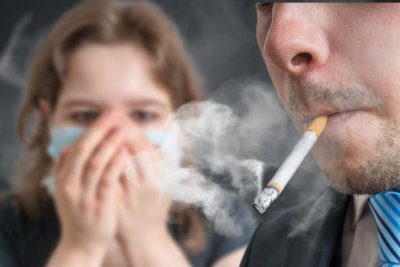If you need indoor air quality (IAQ) surveys to characterize the conditions of your office, warehouse, plant, laboratory, hospital, or any assistance discussed in this information page, call us at 973-366-4660 or email us at info@atlenv.com for details and a free estimate.
Common Indoor Air Quality Testing/Sampling or Surveys Include:

- Mold (including Aspergillus, Penicillium, and Stachybotrys)
- Bacteria (such as Legionella Pneumophila, MSRA, E. coli, etc.)
- Asbestos (found in older buildings)
- Chemicals (VOCs, formaldehyde, ethylene oxide, etc.)
- Dust and particulates (black soot, construction dust)
- Allergens (cat, dog, rat, mouse, dust mite, pollen)
- Carbon dioxide (CO2) and carbon monoxide (CO) (from engines, cars, trucks)
- Tobacco (nicotine) (secondhand smoke)
Phase I – Initial Indoor Air Quality Survey
Usually a one-day investigation of the indoor environment, the initial survey may include the following actions, depending on the situation:
- Preliminary information gathering and fact-finding before the onsite visit to obtain information on the building, its system, occupants, activities, complaints (if any) and illnesses (if any) age of the building, size, type of construction, and the number of floors are also evaluated.
- Investigate general environmental conditions that could affect the Indoor Air Quality (IAQ) in the areas of study. An inspection also is conducted of the HVAC systems supplying these areas (roof units – ground level units), as well as the occupied portions of the building. Also, it is important to focus on any areas where there are specific complaints, such as odors, dust, respiratory irritation, skin irritation, nausea, lethargy, and multiple cases of similar illnesses in one area. Adhesive tape imprints and microscopic examination of the surface materials inside the HVAC system are collected. Pictures may be taken for confirmation purposes.
- Test for general indoor parameters such as temperature, relative humidity, carbon dioxide, carbon monoxide, and total volatile organic compounds. These parameters are measured with direct reading instruments. In specific cases, this can also include oxygen, mercury, sewer gas, and specific chemicals where direct reading instruments are also available.
- Collect Air-O-Cell samples in order to ascertain levels of particles, such as mold/fungal elements and spores, opaque particle fragments, dust, and fibers. This testing/sampling defines the nature of the particles present.
- Collect microbiological samples to test for the presence of molds/fungi, and/or bacteria.
- Sample any chemical agents identified during the preliminary information gathering.
(In all of the above tests, air samples are collected not only from the area(s) of concern but also from the non-complaint area and/or from outdoors for comparison purposes.) This can include VOC’s using Vacuum Summa Canisters or sample bags. - Prepare written report of findings and recommendations listing corrective actions where problems have been identified.
- Provide expert witness or litigation support of the situations requiring legal action.
Phase II – In-Depth IAQ Investigation
Where situations cannot be resolved by a Phase I evaluation and the extent of the problem is greater than anticipated or more testing/sampling and evaluation is necessary, an in-depth indoor air quality (IAQ) investigation would be performed. Each situation is unique but the following are some of the tests that could be performed:
- More extensive examination of the interior of the HVAC System, including opening ductwork and test for molds, bacteria, or chemicals
- Continuous monitoring of basic air quality parameters (CO2, CO, Temp., RH) – 24 hrs/day for up to 14 days
- Testing/sampling and analysis of airborne bacteria/fungi (bioaerosols), mycotoxins, or endotoxins
- Microscopic assays – Air-O-Cells and Transparent Tape Imprints for mold, bacteria, fibers, dander, or pollen
- Particulate assays – microscopic identification of fibers, pollens, fungi, or asbestos
- Chemical assays – Volatile Organic Compounds (VOCs), specific chemicals, and identification of unknowns
- Indoor allergens – dust mites, cat and dog dander, cockroach allergens, endotoxins
- Water Analysis – sampling/testing for Legionella bacteria, E. coli, heavy metals, hardness, or specific analytes
- Testing for formaldehyde – found in furniture, drapes, cloth, paneling, and adhesives
- A detailed report with corrective measures and/or a remediation plan
Phase III – Remediation
Once problems have been identified, we can participate in corrective measures for identified IAQ problems. Using our internal staff or affiliate organizations, we can oversee the necessary corrective measures or recommend reputable contractors. This includes:
- Specifications / Remediation Plans
- Oversight and project management of abatement or remediation
- After remediation demolition but before building back to ensure all water damaged/moldy surfaces have been addressed
- Final air sampling/testing, mold or bacteria sampling/testing, and chemical analysis to ensure clean-up is complete
Phase IV – Expert Witness
A lot of our senior personnel have experience in expert witness and litigation support in matters related to indoor air quality and mold. We have developed expert reports, provided testimony for depositions, and appeared in court for litigation involving the sources and causes of mold development, the extent of remediation required, and insurance claim issues for both commercial and residential situations.
Contact us using our contact form or call 973-366-4660 to discuss your unique needs and obtain a complimentary without obligation quotation for indoor air quality investigation services tailored to your organization’s requirements.



